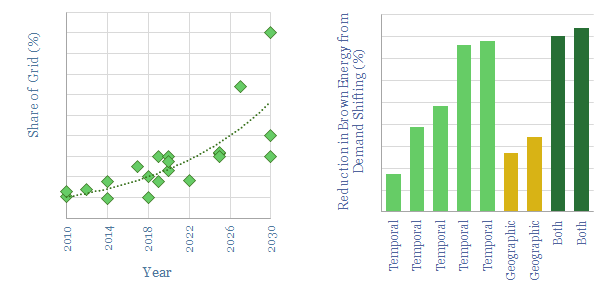This data-file estimates data-centers’ electricity use and ability to demand shift. Large data centers how power demand in the range of 50-500MW. Around 40% of their electrical loads can demand shift, to help smooth out the volatility of renewables?
Data servers store information and execute code to provide specific information in response to incoming requests. They are ‘always on’ and ready to fulfil these requests.
Data servers tend to be housed in large, dedicated facilities called data-centers, which are power-controlled, and supplied with high-grade power electronics.
Hyperscale data centers tend to have >5000 servers, >50MW power demand and >10,000 square feet areas. There might be around 600 globally, out of 6,000 total data-centers globally, as of 2021.
Powering the internet consumed 800 TWH of electricity in 2022, as 5bn users generated 4.7 Zettabytes of traffic. Of that total energy consumption, around one-third is from data-centers, as covered in our note here.
Specifically, our best estimate for 2022 is that a typical data-center is consuming around 80Wh of electricity per GB of data (data here, and more in the note here).
Data centers also matter increasingly, to supply data and perform processing for the rise of AI, which will consume another 500 TWH of electricity by 2030, but likely also unlock 10x more energy savings too (note here).
About half of all internet data consumption today is for streaming long-form video content (>5-minutes), with standard definition running to 1 GB/hr (2.2Mbps), high definition running to 3GB/hr (6.67Mbps) and ultra-HD at 7 GB/hr (15.6Mbps).
A hidden opportunity, explored in this data-file is that data-centers can demand shift in order to help smooth the volatility of renewables.
Around 40% of data-center energy demand can likely be demand-shifted, of which two-thirds is temporal (i.e., shifting the timing of non-critical loads, such as backing up data) and one-third is geographical (i.e., routing processing loads to facilities which have more power available to them, at a given point in time).
The opportunity to improve margins of data-centers by demand shifting is covered in our recent research note here.
Demand shifting at data-centers and other digital facilities could ultimately permit another 1-2% potential share for renewables in the grid, without needing to resort to curtailment, or to install expensive batteries or other backup solutions.
This data-file aggregates data from past studies into the demand-shifting potential of data-centers. Studies and their details are in the Excel.
